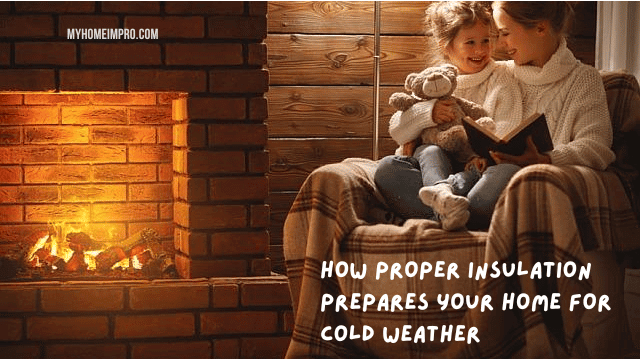As the chilly winds of winter approach, it becomes crucial to gear up your home for the impending cold. Proper insulation, often overlooked, is the unsung hero in this battle against freezing temperatures.
Not only does it provide a warm, cozy environment inside your home, but it also makes significant contributions to energy efficiency and cost savings on your heating bills.
This article will guide you in preparing your home for winter through proper insulation, ensuring you stay comfortable while being environmentally responsible.
Understanding Insulation
Table of Contents
To truly appreciate the importance of insulation, it’s essential to understand what it is and how it works. Insulation is a material that creates a barrier between the inside and outside of your home, reducing heat transfer from one area to another. It does this by trapping pockets of air within its structure, which act as an excellent insulator.
Various types of insulation are available in the market, including fiberglass, cellulose, spray foam, rigid foam, and natural materials such as sheep’s wool. Each type has advantages and disadvantages, but all serve the same purpose of keeping your home warm and comfortable during winter.
Benefits of Proper Insulation
Proper insulation is crucial for keeping your home warm during the cold winter, but offers several other benefits.
- Energy efficiency – Insulation reduces heat transfer, keeping your home warmer for longer. This means you’ll use less energy to heat your home, lowering energy bills.
- Environmental impact – Using less energy saves you money and reduces your carbon footprint. By properly insulating your home, you’re contributing to a greener planet.
- Comfort – Insulation keeps your home warm and reduces outside noise, making your living space more peaceful and comfortable.
Where Should You Insulate?
The key areas to focus on when insulating your home are the attic, walls, floors, and crawl spaces. These are typically where heat loss occurs most significantly, and proper insulation can significantly impact your home’s overall warmth and energy efficiency.
- Attic – Insulating your attic is essential as warm air rises; without proper insulation, it will escape through the roof. This also prevents ice dams from forming on your roof during winter.
- Walls – Walls are another critical area to insulate as they comprise most of your home’s surface area. Insulation can be installed during construction or retrofitted onto existing walls.
- Floors and crawl spaces – Floors above unheated spaces, such as garages or crawl spaces, should also be properly insulated to prevent heat loss.
Signs You Need to Reinsulate
It’s essential to regularly check your insulation to ensure it’s performing at its best. Here are some signs that may indicate you need to reinsulate:
- High energy bills – If you notice a sudden increase in your heating bills, it could be due to insufficient insulation.
- Uneven temperatures – If certain areas of your home are colder than others, it may indicate inadequate insulation.
- Drafts – Drafts around windows, doors, and electrical outlets can indicate gaps in your insulation.
- Ice dams – If you notice icicles forming on your roof or gutters during winter, it could indicate poor attic insulation.
DIY vs. Professional Insulation
When installing insulation, there are two main options to consider – Do It Yourself (DIY) or hire a professional.
DIY Insulation
DIY insulation installation can be a cost-effective solution. You can save on labor costs and have the satisfaction of improving your home yourself. It can be a viable option, particularly for simpler tasks such as laying insulation rolls or boards in the attic.
However, it requires much research, planning, and time. It’s also crucial to remember that the quality of your insulation is only as good as its installation. Poorly installed insulation can lead to gaps, cold spots, and reduced energy efficiency.
Safety is another concern, especially when dealing with older insulation materials that may contain harmful substances like asbestos.
Professional Insulation
Hiring a professional, on the other hand, might be more expensive upfront, but it comes with several benefits. Firstly, professionals bring expertise and experience, ensuring the insulation is installed properly without any gaps or errors.
This can result in better energy efficiency and a more reliably warm and comfortable home. Professionals also possess the right equipment to install different types of insulation, including those that might be challenging for untrained individuals, such as spray foam.
Finally, hiring a professional means you save time and can have peace of mind that the job is done correctly and safely. You can do this by visiting their website or calling them.
Type of Insulation to Use
- Fiberglass insulation – This is the most common type of insulation and comes in two forms: batts (pre-cut sections) and rolls (long continuous pieces). It is made of extremely fine glass fibers and is often installed in attics, walls, and floors. It’s relatively affordable and easy to install but should be handled carefully due to the small glass splinters and dust that can be a respiratory irritant.
- Cellulose insulation – Made from recycled paper products, primarily newsprint, cellulose insulation is a more eco-friendly option. It can be blown into attics, walls, and other hard-to-reach places, providing a good option for retrofit projects. It has a higher R-value (a measure of insulation effectiveness) than fiberglass, but it can be susceptible to moisture damage.
- Spray foam insulation – Spray foam insulation expands and hardens upon contact, making it an excellent choice for filling gaps, cracks, and crevices. It comes in two types: open-cell (lighter and cheaper but less insulating) and closed-cell (more expensive but provides a higher R-value and moisture barrier).
- Rigid foam insulation – Also known as foam board, this type of insulation is often used for insulating basements and crawlspaces. It offers a high R-value and provides an excellent moisture barrier. However, it can be more expensive than other types of insulation.
- Natural insulation – This includes materials such as sheep’s wool, straw, and cotton. These are sustainable, renewable, and have less environmental impact. Sheep’s wool has excellent insulation properties and can absorb moisture without losing its insulating ability. However, these can be more expensive than synthetic options.
Conclusion
Proper insulation is crucial for keeping your home comfortable and energy-efficient, especially during the colder months. It’s important to regularly check your insulation and reinsulate when necessary to ensure optimal performance. Whether you install it yourself or hire a professional, use high-quality insulation that suits your needs and budget.
Remember that investing in proper insulation not only benefits your home but also the environment. So, as we head into winter, prepare your home with proper insulation and stay warm all season long.

